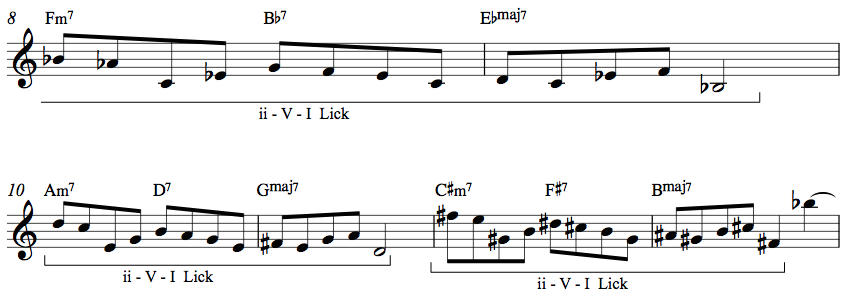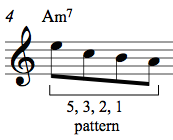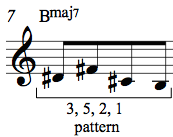Funky Giant Steps Solo

Many students are unnerved by the challenge of trying to solo over the chord changes to "Giant Steps." And rightfully so - it's a hard set of chord changes to navigate. But the pros understand that simple, melodic ideas and contours can be hugely effective and can sound very advanced.
In this article, we're going to deconstruct this one-chorus funky improvisation over the "Giant Steps" chord changes. By the end, I think you'll have a pretty good illustration of how to develop a solo using one underlying theme (i.e., motivic development) and how a couple simple ideas can really sound quite advanced without any need to try to play "outside" the changes or use complex re-harmonizations of the chords.
Let's break this solo down to make sure we understand all aspects of what's going on.
First, listen again at a slower tempo: "Funky Giant Steps Solo" at 84bpm:
Second, download the transcription to the Funky Giant Steps solo.
- The chord changes to "Giant Steps" are themselves built on a pattern that goes up a minor 3rd, and then down a 5th, up a minor 3rd, then down a 5th, eventually cycling through a set of ii-V-I progressions, each of which start a tritone (augmented 4th/diminished 5th) away from where the previous progression resolved. Understanding this helps make sense of the tune because you should realize that there is a lot of V-I movement.
- The track features drums, bass, keys, and a synth "lead" line. The bass is playing only the roots of each chord. The keys are playing the chords as they are written, without any reharms or substitutions.
- There are 2 prevalent ideas in the solo: the first is a simple pentatonic pattern using the 1st, 2nd, 3rd, and 5th scale degrees of the given chord (usually in that order - 1-2-3-5 - or in some variation of that order - i.e., measure 4 plays the patter in reverse, 5-3-2-1). The second idea is a simple ii-V-I lick that is played over each ii-V-I progression and uses notes only from those chord scales (i.e., no chromatic or "outside" notes).
- All other notes used in the solo are scale tones which are diatonic to each chord. Not counting the final two measures (which simply rip a B major line all the way down the keyboard) there are only 3 notes in the entire 16-measure solo which can be called chromatic or "outside" notes.
So let's take a look at the 2 prevailing ideas in this solo:
First, the pentatonic 1,2,3,5 pattern, which appears repeatedly through the first 7 measures:
Second, let's look at the ii-V-I lick that repeats three times from measures 8-13:
Notice that from these 2 basic ideas - the pentatonic pattern in measures 1-7, and the ii-V-I lick in measures 8-13 - we have created a great-sounding solo that extends for almost the entire 16-bar chorus. You can get a lot of mileage out of the pentatonic pattern simply by varying the order of the 4 notes (as we see in measures 4 and 7).
Now that we've dissected exactly what's going on in this solo, listen again at full speed (120bpm):
Now that you see how you can build a great-sounding solo using "inside" (i.e., diatonic) notes even on challenging forms like"Giant Steps," get started using these ideas in your own playing!


